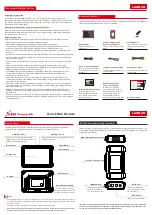
Safety Light Curtain
59
5.2.4.1 Muting Signals
Muting signals are for:
• Detecting the material (object) to be transported
• Forwarding the detection signal to the ESPE to activate muting
• Detecting the removal of the object
• Forwarding the free signal to the ESPE to deactivate muting
Muting signals can be generated, for example, by:
• Optical sensors, e.g.:
– Retro-reflex sensors
– Through-beam sensors
– Reflex sensors
• Inductive sensors
• Signals from the software (e.g. control)
NOTE!
• When using connection box ZFBB001, the output of the muting sensor must be on Pin 4.
• Please note the following switching characteristics when using optical sensors:
– Through-beam sensor: dark switching (normally closed) (PNP NC)
– Reflex sensor: light switching (normally open) (PNP NO)
– Retro-reflex sensor: dark switching (normally closed) (PNP NC)
DANGER!
• A muting signal must not be connected to multiple inputs. Each signal must only be
assigned to one input.
• The user must take suitable measures (see EN ISO 13849-2, Tab. D.4) to prevent
cross-connection between muting signals.
DANGER!
• When mounting the MS, ensure that people are still reliably detected by the ESPE and
that they can not initiate or carry out a valid muting sequence.
• The formula listed for the relevant muting types must be used for calculating the minimal
clearance.
ATTENTION!
When mounting the MS, ensure that the material is detected correctly. The actual means of
transport (e.g. pallet) should not be detected.
NOTE!
• The suitable MS should be chosen depending on the properties of the material to be
detected. For metal objects, for example, it is advisable to use inductive sensors.
• The correct parametrization must be observed depending on the sensor type used. For re-
flex sensors with background suppression, for example, the sensor must be configured so
that the object is detected at an adequate distance from the safety field of the ESPE, while
larger distances are suppressed.
















































